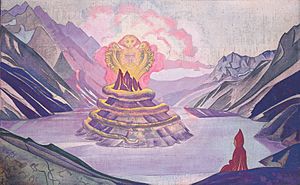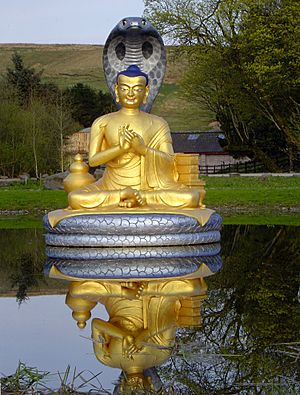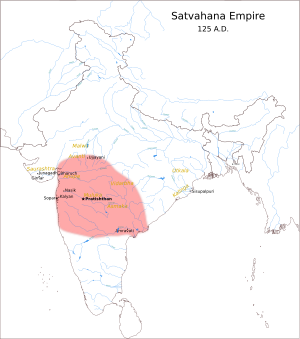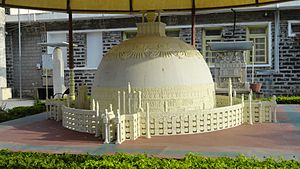Nagarjuna facts for kids
Quick facts for kids
Nāgārjuna
|
|
|---|---|
| Born | c. 150 CE (disputed); |
| Died | c. 250 CE India
|
|
Notable work
|
Mūlamadhyamakakārikā |
| Era | Ancient philosophy |
| Region | Eastern philosophy |
| School | |
|
Notable ideas
|
|
Nāgārjuna (around 150 – 250 CE) was an important Buddhist thinker, teacher, and philosopher from ancient India. Many people consider him one of the most important Buddhist philosophers ever. He is seen as a "great thinker in the history of Asian philosophy."
Nāgārjuna is known for starting the Madhyamaka school of Buddhist philosophy. This school focuses on the "middle way." He also helped spread the Mahāyāna movement in Buddhism. His most famous book is the Mūlamadhyamakakārikā. It talks about the idea of emptiness. This book has been studied for centuries and inspired many other writings.
Contents
Nāgārjuna's Life and Times
Ancient India's Buddhist World
During Nāgārjuna's time (1st and 2nd centuries CE), India was divided into many different kingdoms. These included the Kushan Empire and the Satavahana Kingdom. Buddhism was already popular and had spread across India.
At this time, the Buddhist community had different groups. The Mahāyāna movement was just beginning. It was a smaller group of Buddhists in India back then. Early Mahāyāna Sūtras, like the Aṣṭasāhasrikā Prajñāpāramitā, were already being shared among some Mahāyāna followers.
What We Know About His Life
We don't know much for sure about Nāgārjuna's life. Historians disagree on exactly when or where he lived. The oldest stories about him were written centuries after he died. These stories are mostly legends, not proven facts.
Some scholars believe Nāgārjuna was an advisor to a king of the Satavahana dynasty. This kingdom ruled in the Deccan Plateau during the 2nd century. Many old legends also support this idea. If true, the king might have been Yajna Sri Satakarni. This connection helps historians guess that Nāgārjuna lived around 150–250 CE.
It's thought that Nāgārjuna might have lived in a monastery where Mahāyāna Buddhists were a minority. He likely wrote one of his important works, the Ratnavali, in the Andhra region around Dhanyakataka (modern-day Amaravati) in the late 2nd century.
Traditional Stories and Legends
The earliest legends about Nāgārjuna come from a biography translated into Chinese around 405 CE. This story says Nāgārjuna was born into a Brahmin family and later became a Buddhist. Legends place his birth in different parts of India, like the Vidarbha region or south Kosala.
Traditional stories say Nāgārjuna was linked to the Prajnaparamita sūtras. These are important Buddhist scriptures. Some legends say he found these scriptures in the land of the nāgas. Nāgas are snake-like beings with magical powers in Indian myths.

Nāgārjuna is often shown as part human, part nāga. Nāgas are wise serpents or dragons. They are believed to bring rain and are found in Hindu, Buddhist, and Jain stories. In Buddhism, a nāga can symbolize a very wise person.
Some legends also claim Nāgārjuna practiced Ayurvedic alchemy. This means he could supposedly turn rocks into gold or make invisibility elixirs. Tibetan stories say he studied at Nālanda University. However, some scholars doubt this because the university wasn't a major center until later. Also, travelers who studied Nāgārjuna's texts there didn't mention any local stories about him.
Some historians say that later in life, Nāgārjuna lived on a mountain called Śrīparvata. This was near a city later named Nagarjunakonda ("Hill of Nāgārjuna"). But there's no proof from archaeological digs that Nāgārjuna lived there. The name "Nāgārjunakoṇḍa" came much later.
Other People Named Nāgārjuna
Many texts are said to be written by "Nāgārjuna." But some of these texts were written much later. This has caused confusion. Modern scholars wonder how many different writers named Nāgārjuna there were. The name is still popular in India today.
Some scholars think there was a different Nāgārjuna who wrote about Ayurveda. There might also have been a later Tantric Buddhist writer with the same name. This person might have been a scholar at Nālandā University. He wrote about Buddhist tantra.
There was also a Jain figure named Nāgārjuna. Stories about him might have influenced the Buddhist legends.
Nāgārjuna's Writings
Many important texts are believed to be written by Nāgārjuna. However, because many fake writings were attributed to him, scholars debate which ones are truly his.
Mūlamadhyamakakārikā
The Mūlamadhyamakakārikā (Root Verses on the Middle Way) is Nāgārjuna's most famous work. It explains the Buddha's teachings. It also carefully looks at many important Buddhist talks.
In this book, Nāgārjuna says that all things we experience are "empty" (sunya). This doesn't mean they don't exist. It means they don't have a permanent, unchanging "self-nature" (svabhāva). They are like a dream, just projections of our minds. Since we experience them, they are not just names.
Main Works Attributed to Him
Scholars have different ideas about which works are definitely Nāgārjuna's. Here are some that many scholars agree on:
- Mūlamadhyamaka-kārikā (Fundamental Verses of the Middle Way, MMK)
- Śūnyatāsaptati (Seventy Verses on Emptiness)
- Vigrahavyāvartanī (The End of Disputes)
- Vaidalyaprakaraṇa (Pulverizing the Categories), which criticizes ideas from Indian Nyaya philosophy.
- Yuktiṣāṣṭika (Sixty Verses on Reasoning)
- Catuḥstava (Four Hymns)
- Ratnāvalī (Precious Garland), a talk for an Indian king.
- Pratītyasamutpādahṝdayakārika (Verses on the heart of Dependent Arising)
- Sūtrasamuccaya, a collection of sutra passages.
- Suhṛllekha (Letter to a Good Friend)
Some scholars, like Paul Williams, have argued that some of these texts, like the Bodhicittavivaraṇa, were written later. Jan Westerhoff focuses on six works that are widely accepted and show a clear, consistent philosophy. These are the MMK, Vigrahavyāvartanī, Śūnyatāsaptati, Yuktiṣāṣṭika, Vaidalyaprakaraṇa and Ratnāvalī.
Other Works
Many other works are said to be by Nāgārjuna, but their true author is often debated. Some might be authentic, while others are probably not. For example, the Dà zhìdù lùn (Commentary on the great prajñaparamita) is very important in Chinese Buddhism. But some scholars doubt Nāgārjuna wrote it. It only exists in a Chinese translation and is not known in Tibetan or Indian traditions.
Some works important in esoteric Buddhism are also linked to Nāgārjuna. But historians often explain this by saying these were "mystical revelations" or written by a "Nagarjuna II" who lived much later.
Nāgārjuna's Big Ideas

Emptiness (Śūnyatā)
Nāgārjuna's main idea is śūnyatā, or "emptiness." This idea connects other key Buddhist teachings, like "not-self" (anātman) and "dependent origination" (pratītyasamutpāda). He used it to challenge other philosophical ideas of his time.
For Nāgārjuna, it's not just living beings that are "selfless." All things (dhammas) are without any "self-nature" (svabhāva). This means they don't have an unchanging, independent essence. They are "empty" of existing on their own. This is because everything depends on other things to come into being.
Nāgārjuna believed that anything truly "real" would have its own nature. It would not be created by causes and would not depend on anything else.
He used a logical tool called the tetralemma to show problems with ideas of inherent essence. This tool looks at four possibilities:
- Things exist.
- Things do not exist.
- Things both exist and do not exist.
- Things neither exist nor do not exist.
Saying all things are "empty" means denying any fixed foundation for existence. So, Nāgārjuna's view is often seen as saying there's no ultimate, unchanging reality.
Understanding emptiness helps us reach nirvana. Nāgārjuna's philosophy aims to correct our minds. We often mistakenly think things have a fixed "self-nature."
Some scholars used to think Nāgārjuna invented the idea of emptiness. But newer research suggests he was explaining and clarifying existing Buddhist teachings. He showed how emptiness and dependent origination are deeply connected.
Two Truths
Nāgārjuna also helped develop the two truths doctrine. This teaching says there are two levels of truth in Buddhism:
- Ultimate truth (paramārtha satya): This is the truth that everything is empty of essence. Even emptiness itself is empty.
- Conventional truth (saṃvṛtisatya): This is the everyday, superficial truth.
Some people think ultimate truth is a deep, unexplainable reality beyond our minds. But others, like Mark Siderits, argue that Nāgārjuna meant "the ultimate truth is that there is no ultimate truth." This means there are only conventional truths.
Nāgārjuna's ideas about these two truths help explain the "middle way." This path avoids the extremes of believing things either fully exist or fully don't exist.
Causality
Nāgārjuna looked at how things cause other things to happen. He used the Four Noble Truths and dependent origination. He saw two types of dependent origination in a causal process: what causes effects and what causes conditions.
This idea is linked to the two truth doctrine. Both effects and conditions are "empty" in their existence. For Nāgārjuna, a cause is something that has the power to bring about an effect. Conditions are other things that help an event happen. He argued against the idea of a hidden, magical connection between causes and effects.
He said that things exist conventionally but are ultimately empty. This helps us understand causality in the Middle Way. This way, we see that things are empty of fixed existence, even in how they cause other things.
Relativity
Nāgārjuna also taught about relativity. In his Ratnāvalī, he gives an example: "shortness" only makes sense when compared to "length." We can only define something by comparing it to other things. He said that "short" and "long" don't have their own fixed nature.
This idea is also found in older Buddhist texts. For example, light exists because of darkness. Good exists because of bad. Space exists because of form. Everything is related and depends on other things for its meaning.
Nāgārjuna and Other Ideas
Hinduism
Nāgārjuna knew a lot about classical Hindu philosophies like Samkhya and Vaiseshika. He understood the ideas of the Hindu Nyaya school. He even wrote about how we gain knowledge, simplifying some of their ideas. He criticized some of the Nyaya theories about how we know things.
Mahāyāna Buddhism
Nāgārjuna was familiar with many Buddhist philosophies and the Mahāyāna tradition. It's hard to say exactly which Buddhist group he belonged to because many old writings are lost. But if the most accepted texts are truly his, then he was clearly a Mahāyānist.
However, his philosophy also closely follows the older Buddhist scriptures. He refers to Mahāyāna texts but always stays within the teachings of the older Buddhist canon. Nāgārjuna might have developed his ideas to explain the Buddha's teachings in a consistent way. He saw the Buddha not just as a pioneer, but as the true founder of the Madhyamaka system.
Pyrrhonism
There are many similarities between Nāgārjuna's philosophy and Pyrrhonism, a type of ancient Greek skepticism. Some scholars wonder if Nāgārjuna was influenced by Greek texts brought to India. Pyrrho of Elis, who started Pyrrhonism, traveled to India with Alexander the Great's army. He studied with Indian philosophers. Some believe Pyrrho's teachings were based on Buddhism. This is because his key ideas were found in Indian philosophy at the time, not in Greece.
See also
 In Spanish: Nāgārjuna para niños
In Spanish: Nāgārjuna para niños
- Acharya Nagarjuna University
- Aryadeva
- Buddhapālita
- Buddhism
- Kamalasila
- Middle Way
- Śāntarakṣita
- Sun Simiao
- Śūnyatā
- Yogachara-Madhyamaka




